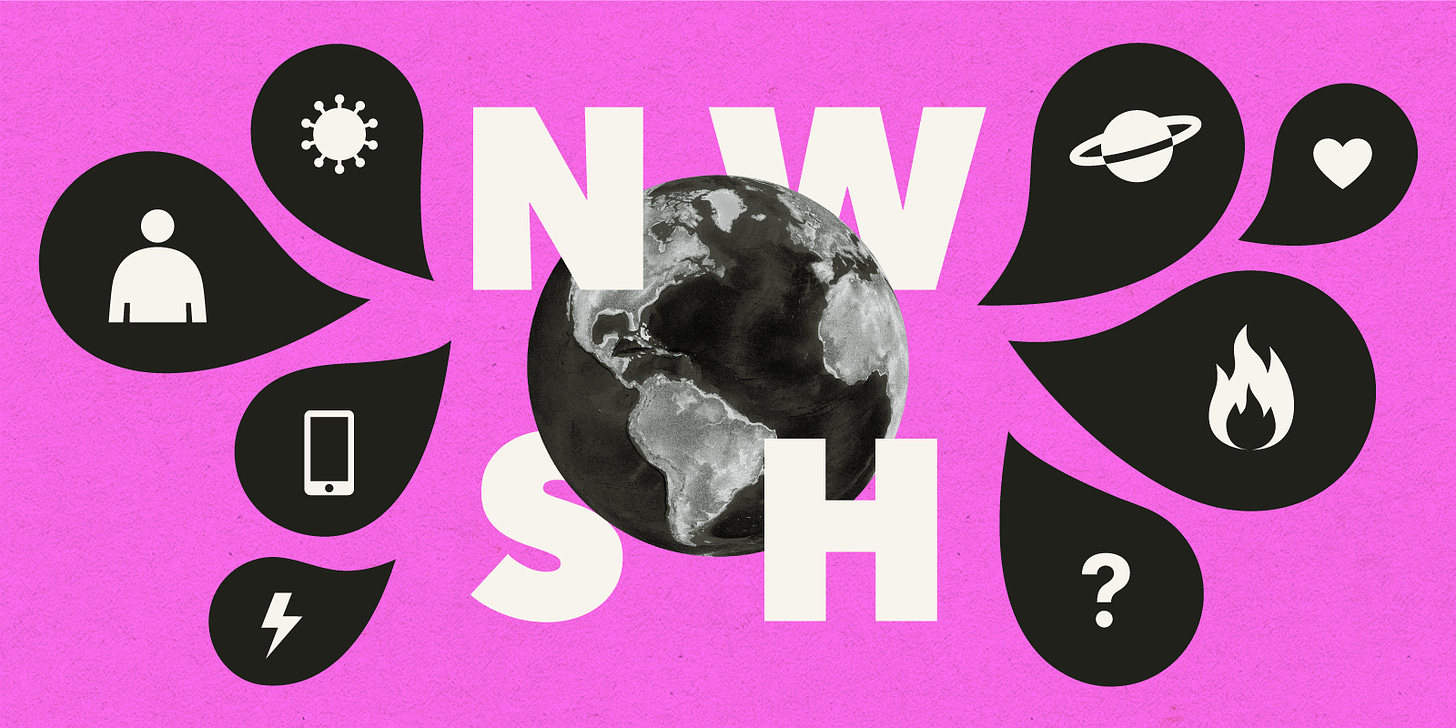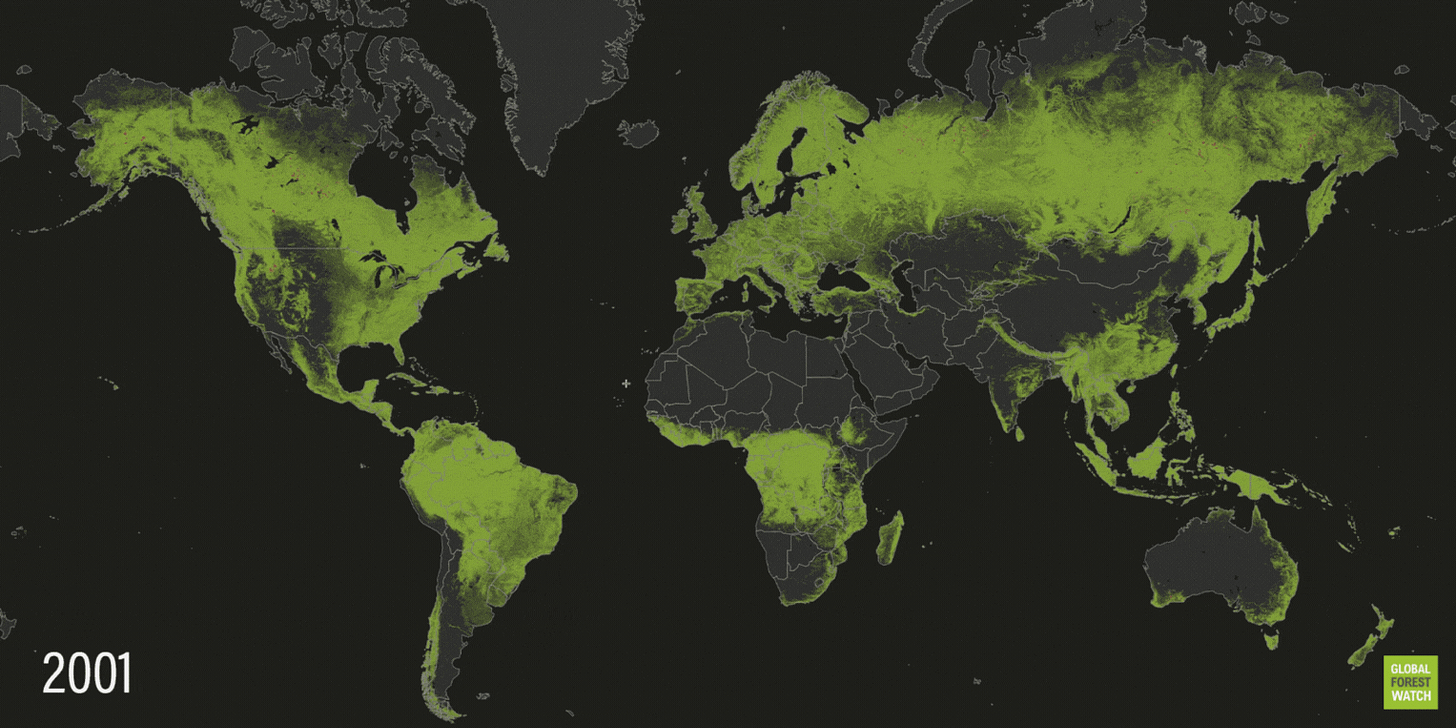Welcome to the mid-week update from New World Same Humans, a newsletter on trends, technology, and society by David Mattin.
If you’re reading this and haven’t yet subscribed, join 22,000+ curious souls on a journey to build a better future 🚀🔮
To Begin
This week, Google and Xiaomi deliver Big Robot Energy.
Meanwhile, a new study reveals just how much forest our planet is losing to fire. And Chinese technology giants reveal their secrets to the CCP.
Let’s get into it!
🤖 OK robot
This week, technology companies continued to usher us all towards a robot revolution.
Google opened the door on research that marries two cutting-edge technologies: its massive AI language model, PaLM, and the hardware taking shape inside its Everyday Robots division. They’re calling the combined system PaLM-SayCan.
The result are robots that can understand novel and unstructured commands — I spilled my orange soda, can you throw it away please? — and then enact an appropriate response.
Google say this is the first time robots have been brought together with cutting-edge language models.
Meanwhile, Chinese tech giant Xiaomi unveiled a humanoid robot called CyberOne. The device stands five feet and seven inches and appeared at a Xiaomi event in Beijing this week, where it waddled towards founder and CEO Lei Jun:

It seems CyberOne can do little more than walk (which is far from nothing); a Xiaomi press release calls the robot, ‘a symbol of Xiaomi’s dedication to incubate a technological ecosystem’.
⚡ NWSH Take: Natural language models and robots; it was only a matter of time before they collided. Google’s work on this is still embryonic. When one of the Everyday Robots fetches a can of soda it is, currently, a painstaking affair. But this research could one day deliver the kind of all-purpose, conversationally competent helper robot that my generation was promised by The Jetsons; ok Googlebot, load the dishwasher. Before we embrace that future, though, we need to ask: what kind of helper robots will truly set us free? And what kind will only serve, in the end, to wrap us in new constraints? Read Our Coming Robot Utopia for more on that. // Meanwhile Xiaomi’s big ta-da this week is a sign of the robot wars to come. Observers didn’t fail to notice that CyberOne is a clone of Tesla’s much-trailed Optimus robot, which Elon Musk promised would be unveiled this September. The robots are too similar, and the dates are too close, for all this to be a coincidence — looks like Lei Jun was determined to beat Elon to the punch. But in the coming war to own the all-purpose robot space, the fighting will only get fiercer.
🌳 Ever decreasing circles
A new paper this week gives a shocking view of the impact of wildfires on trees.
Researchers at the University of Maryland used historical satellite images to analyse loss of forests by fire. The resulting study, released via Global Forest Watch, is the most detailed look ever produced at the impact of fires on forests around the world.
It reveals that the amount of forest lost to fire annually has doubled across the last 20 years. This includes forest lost both to wildfires and fires that were intentionally set. In the visualisation below, pay particular attention to Russia and north America:
In 2021, 9 million hectares of forest burned; that amounts to an area the size of Portugal, or 16 football pitches every minute.
Global Forest Watch say climate change, and a resulting increase in wildfires, is behind the change.
⚡ NWSH Take: It’s almost as if the natural environment is a complex system in which everything is connected to everything else. Okay, enough sarcasm. But this news is a perfect example of the sorts of dark feedback loops we’ll witness ever more often as the century wears on. A hotter planet means more fires, which means fewer trees, which means more a hotter planet, and round we go again. // Another dark loop? Pair this news with further revelations this week that Antarctica’s ice shelves may be melting faster than previously believed. This melting renders the Antarctic less reflective, thereby accelerating heating. // These kinds of feedback loops, which spiral rapidly once triggered, are one reason why modelling the impacts of a heated planet is so hard. There are already reasons to believe that they’re causing global temperatures to rise faster than expected, and fuelling more extreme weather than we thought we’d face in 2022. NWSH will keep watching.
🧮 Algorithms for the people
This week, a raft of Chinese technology giants let central government peer into the inner-workings of their most secret algorithms.
Companies including TikTok, Baidu, and Tencent were responding to new laws that require them to share their algorithmic secret sauce with the all-powerful internet regulator, the Cyberspace Administration of China.
The move towards total oversight of the most powerful online algorithms — which shape the viewing, reading, and purchasing of billions — has no parallel in the Global North. Want to know how Douyin (the Chinese version of TikTok) recommends videos? How Alibaba pushes products? The CCP now does know this, and a whole lot more.
Via a strange coincidence, this week also saw US tech company Oracle began an audit of TikTok’s algorithms and content moderation practises, to ensure they aren’t being manipulated by the Chinese authorities.
TikTok routes its data through Oracle’s cloud services; it is submitting to the audit as part of an initiative intended to reassure US lawmakers that its social video platform is not under the secret control of the CCP. Last week I covered new data from Pew Research that revealed that 67% of US teens say they’ve used TikTok.
⚡ NWSH Take: Two stories, two views of the ongoing collision between governmental and algorithmic power. // China’s move on oversight is underlain by a truth that has long been clear: the CCP is not going to allow technology platforms to continue to amass vast and unaccountable power the way they have in the Global North. Instead, via a form of regulatory jiu jitsu, they’re going to harness that power and use it to strengthen their hold over the tech barons and everyone else. It’s all part of their plan to build a never-before seen form of techno-authoritarianism, which I wrote about in Algorithms With Chinese Characteristics, and which will see big tech platforms forced to share user data with central government. // Meanwhile, Oracle’s audit of TikTok is an early example of the emerging geopolitics of algorithms. For years TikTok’s parent company, ByteDance, promised that data from the US app was not accessible in China; in June it finally admitted that some data had been sent to China. Now, US senators want assurance that the platform is not an indirect spy/soft power vehicle for the CCP. As China becomes more globally assertive, expect the Global North to impose more checks on Chinese-grown tech companies; this process is part of what will lead us further towards the splinternet.
🗓️ Also this week
🖼 This viral Twitter thread asked: if an AI image generator is trained on work by living artists, should those artists be compensated? A new AI called Stable Diffusion boasts the ability to emulate the style of a wide range of contemporary artists; this raises the possibility, says the thread, that those artists will lose out on commissions. This newsletter is obsessed with the intersection between AI and the creative life; see, for example, New Week #21 and the story of late Korean singer Kim Kwang-seok.
👨💻 Apple says (again) that employees must come back to the office at least three days per week. The memo from CEO Tim Cook says the shift will start next month, and that employees must come in on Tuesdays and Thursdays. A previous memo called employees back in May, but it was ‘paused’ after widespread internal dissent.
🛫 American Airlines says it will buy 20 supersonic passenger jets from US startup Boom Supersonic. Boom says its Overture jet will be able to fly from London to NYC in three-and-a-half hours; roll out of the jets is expected in 2026.
🏠 Amazon will launch a TV clips show that features footage from its Ring doorbells. Ring Nation will be presented by comedian Wanda Sykes, and will features clips drawn from Ring doorbells across the US. Expect ‘neighbours saving neighbours, marriage proposals, military reunions and silly animals’. LOL.
🥳 Airbnb says it will use ‘anti-party technology’ to stop people from booking properties so they can use them for a party. The new screening system looks at a user’s booking history, place of residence, and other factors to attempt to screen out party animals.
🐯 A US startup plans to resurrect the iconic and long-extinct Tasmanian tiger. The last known Tasmanian tiger died in 1936; now Colossal Biosciences says it will work to resurrect the creature and reintroduce it to selected locations on the Australian mainland. Back in New Week #52 I first wrote about Colossal and their quest to bring back the woolly mammoth.
🌊 The risk of a catastrophic ‘megaflood’ in California has doubled due to climate change, according to new study. UCLA researchers used high resolution climate modelling to assess the risk of an event as severe as the state’s 1862 Great Flood. Meanwhile, California is currently experiencing one of the worst droughts in its history. Back in New Week #92 I wrote about floods as a megaforce that will shape the 21st-century.
🤯 Former WeWork CEO Adam Neumann’s new real estate company, Flow, has received a $350 million investment from VC firm Andreessen Horowitz. Neumann left WeWork in 2019 after a failed IPO exposed a chaotic internal culture and saw the company’s valuation collapse. Andreessen’s investment in Flow is the single largest cheque it has ever written; in a press release Marc Andreessen called Neumann a ‘visionary leader’. The press release made no mention of Neumann’s other project, a crypto startup called Flowcarbon, which received a $70 million investment earlier this year. That project is now reported to be paused.
🌍 Humans of Earth
Key metrics to help you keep track of Project Human.
🙋 Global population: 7,968,508,852
🌊 Earths currently needed: 1.7870799982
💉 Global population vaccinated: 62.0%
🗓️ 2022 progress bar: 63% complete
📖 On this day: On 19 August 1848 the New York Herald breaks news of the California Gold Rush, which had begun in January of that year.
Beep Bop Boop
Thanks for reading this week.
The coming home robot revolution — and the trade offs it will present to us — are a classic case of new world, same humans.
This newsletter will keep watching, and working to make sense of what it means for our shared future. And there’s one thing you can do to help: share!
Now that you’ve made it to the end of this week’s instalment, why not forward the email to someone who’d also enjoy it? Or share it across one of your social networks, with a note on why you found it valuable. Remember: the larger and more diverse the NWSH community becomes, the better for all of us.
I’ll be back on next week. Until then, be well,
David.
P.S Huge thanks to Nikki Ritmeijer for the illustration at the top of this email. And to Monique van Dusseldorp for additional research and analysis.
















New Week #95